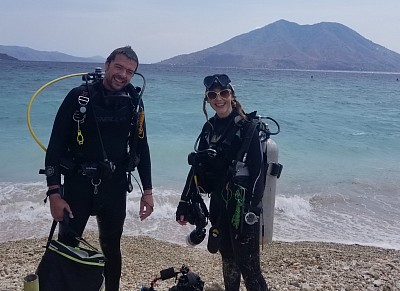The British Society of Underwater Photographers Magazine: Winter Edition 2020
IN THE WAKE OF A PANDEMIC
by Jay and Dan Shipp
"Protect the ocean, and you protect yourself" - Jean-Michel Cousteau
It was early on a Fijian December morning in 2019. A light breeze, blue skies and a calm sea staged the perfect day for a diving excursion with the Jean-Michel Cousteau dive team. We boarded the Raluva Ni Wasa (Princess of the Ocean) and set off excitedly towards our destination - our brief, to shoot promotional photos and videos for the Jean-Michel Cousteau dive shop. The destination was Namenalala, a small idyllic island in the tropical South Pacific, a few kilometres south of Vanua Levu. It is a tiny volcanic island, but one which packs a punch. A white sandy beach skirts a lush green jungle interior. Red-footed Boobies circle above, while frigate birds soar higher still, exploiting the tropical thermals.
Namenalala sits within the Namena Barrier Reef, a horseshoe-shaped system which extends out to the Koro Sea. Both the island and the Namena Barrier Reef, which surrounds it, stand as a symbol of positive human intervention and community awareness. In 1997, Namena became Fiji's largest no-take marine reserve - a decision established by the chiefs from ten villages in the district. The initiative was a success - rejuvenating world-class dive sites in an area which was once under serious threat.
Neu, our Fijian dive guide, hands us a couple of dive tags – a requirement when diving within the reserve. The tags cost thirty Fijian dollars each. This money goes towards funding the no-take zone patrols, providing dive boat buoys, and educating local children. We were more than happy to pay.
Grand Central Station is the name given to one of the best dive sites in the reserve. We plunged into the water, keen to witness its beauty, and discovered, as the name suggests, a site bustling with life. Schooling Jacks, Barracuda, and several shark species welcomed us alongside colourful, hard and soft corals and abundant reef life. The experience exceeded our expectations. We left the reserve feeling optimistic about the future of this extraordinary marine haven.
Three months after visiting Grand Central Station, we could not have predicted how precarious the marine reserve's future balance might be. COVID-19 loomed, and with it, a change to the Fijian way of life. We witnessed this change firsthand. We had decided to stay in Fiji as the virus raged across the globe and the borders closed. We watched as other travellers made their way back to their respective countries, and we witnessed firsthand the repercussions that the COVID-19 virus had on a country that relies so heavily on tourism. Village chiefs along the coast took action by partially lifting the tabu status on their traditional fishing grounds to provide food for the people. The simple reality was that communities were fishing for subsistence and had to prioritize their survival over any potential impact this may have caused on underwater ecosystems. We spent eighteen months in Fiji. During that time, we could only hope that the virus would eventually run its course. The loss of revenue from tourism was costing the country dearly.
Over a year has passed, and daily life is becoming more accessible in the pandemic's wake. What of Namena? We finally got to see how the mayhem of 2020 affected the marine reserve. The sky was laden with tropical rainfall this time, and the water was a squall. The conditions were far from ideal, but we were keen to see how the reef had fared. We wondered if the large schools of fish and sharks were still there. To our relief, they were. The isolation of the Namena Marine Reserve is its saving grace, and it seems safe - for now. Without tourism, the people of Fiji will suffer, and the ripple effect may be detrimental to some of our much-loved dive sites. Jean-Michel Cousteau's quote is a compelling ecological message that is difficult to implement during a pandemic. How can the oceans protect the people of Fiji when people find it challenging to protect the ocean?
DIVING ALOR ON A BUDGET
We love to travel; we love diving - simple. A few years ago, we took our shoestring wilderness dive trips one step further. We quit our jobs, rented our house and hoped it would fund a new lifestyle. Fast forward two and a half years, and we’ve got a fair bit of practice at sniffing out the ‘can-visit, can-dive’ places that may seem too expensive at first glance. This article is not about liveaboards or luxury accommodation but about how we have made ends meet.
The waters around the west coast of Alor Island offer a wealth of subject matter for underwater photographers, divers, and keen snorkelers. Pristine coral reefs bust with life that ranges from top predators and large pelagic creatures to an outstanding array of macro subjects. Nourished by the nutrient-rich waters of the Pantar Strait, the reefs are undeniably some of the most beautiful we have encountered. Sustainable fishing practices and a complete lack of commercialism have helped protect the marine biodiversity inhabiting this special environment. Alor has a good variety of dive sites, too. Caves, coral gardens, walls, and muck diving are all here.


